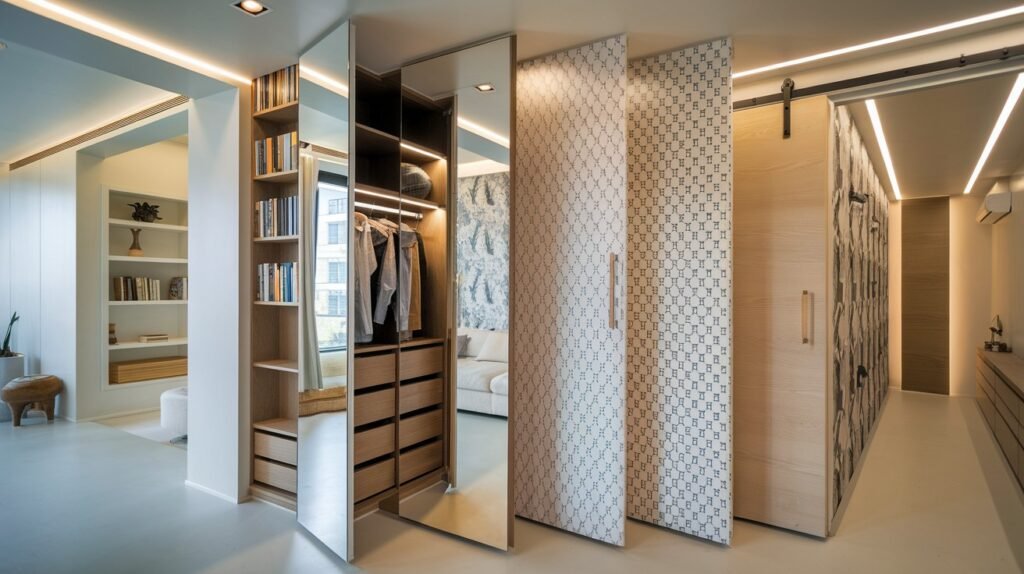Living in a compact home doesn’t mean sacrificing style or functionality. When square footage is limited, every inch counts, and that includes the space occupied by your closet doors.
Traditional swinging doors can consume valuable space and create visual clutter that makes small areas feel even more cramped.
Enter the world of creative concealment: hidden closet door ideas that change ordinary storage into extraordinary design features.
These clever solutions do double duty, providing essential storage access while maintaining clean lines and open flow.
From bookshelf facades to mirror panels, these innovative approaches can make your closet completely disappear into your decor.
Ready to maximize your space while adding an element of surprise? Let’s look at 11 brilliant ways to hide your closet in plain sight.
Why Choose a Hidden Closet Door?
Benefits for small spaces
- Maximizes usable space by eliminating door swing clearance
- Creates clean, streamlined walls without visual interruption
- Adds a “wow” or surprise element to any room
- Reduces visual clutter for a more open feel
- Allows furniture placement closer to walls
- Maintains consistent wall flow and design continuity
Perfect for various living situations
Studio apartments benefit from space-saving designs, while minimalist homes maintain their clean look. Kids’ rooms gain an extra play area without door swing zones.
Bedrooms with limited floor space can position beds and dressers closer to the walls. Home offices create professional appearances, and guest rooms offer streamlined looks.
Rental properties allow creative solutions without major modifications, making these doors ideal for temporary or permanent living arrangements across different home styles and sizes.
11 Creative Hidden Closet Door Ideas for Small Spaces
1. Bookshelf Door
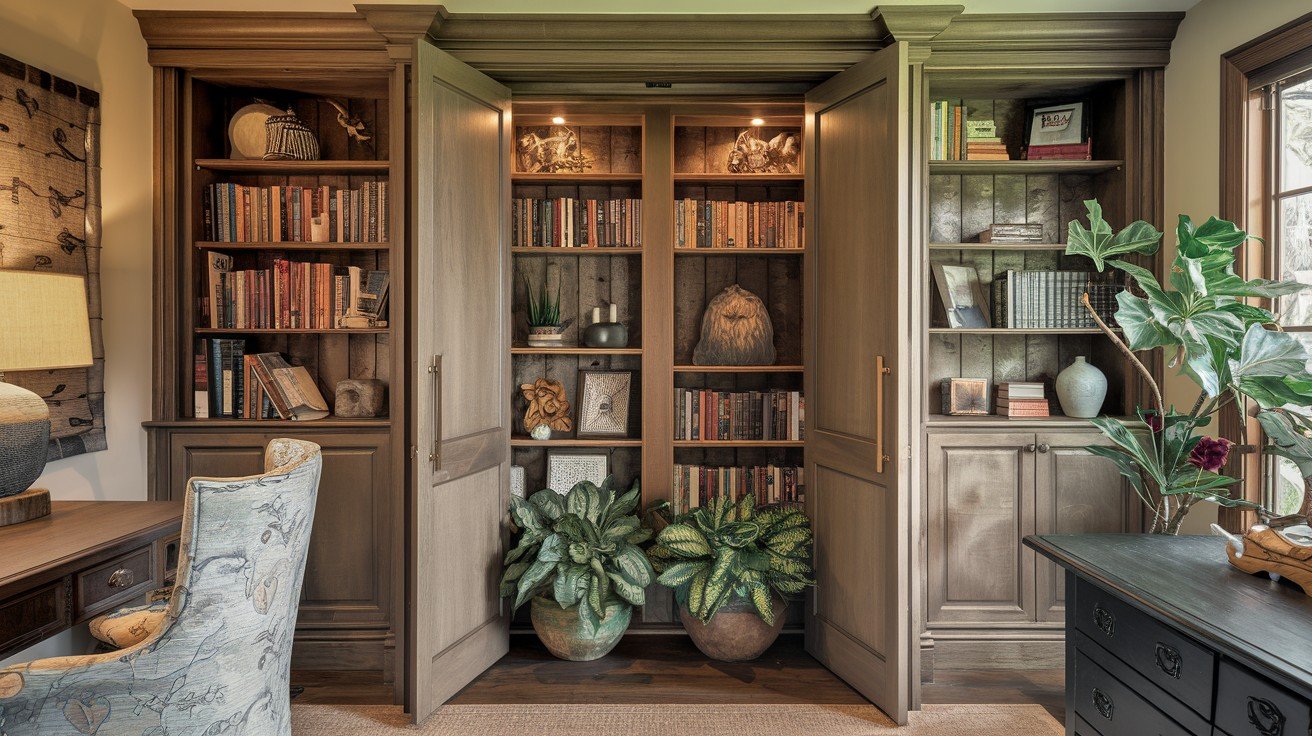
Upgrade your closet entrance into a functional library wall. This design features real shelves holding books and decorative items, creating authentic storage while concealing your closet.
Install hinges on one side to swing open like a secret passage. Works exceptionally well in home offices, bedrooms, or study areas where books naturally belong, adding intellectual charm while maintaining complete functionality.
2. Mirror Door
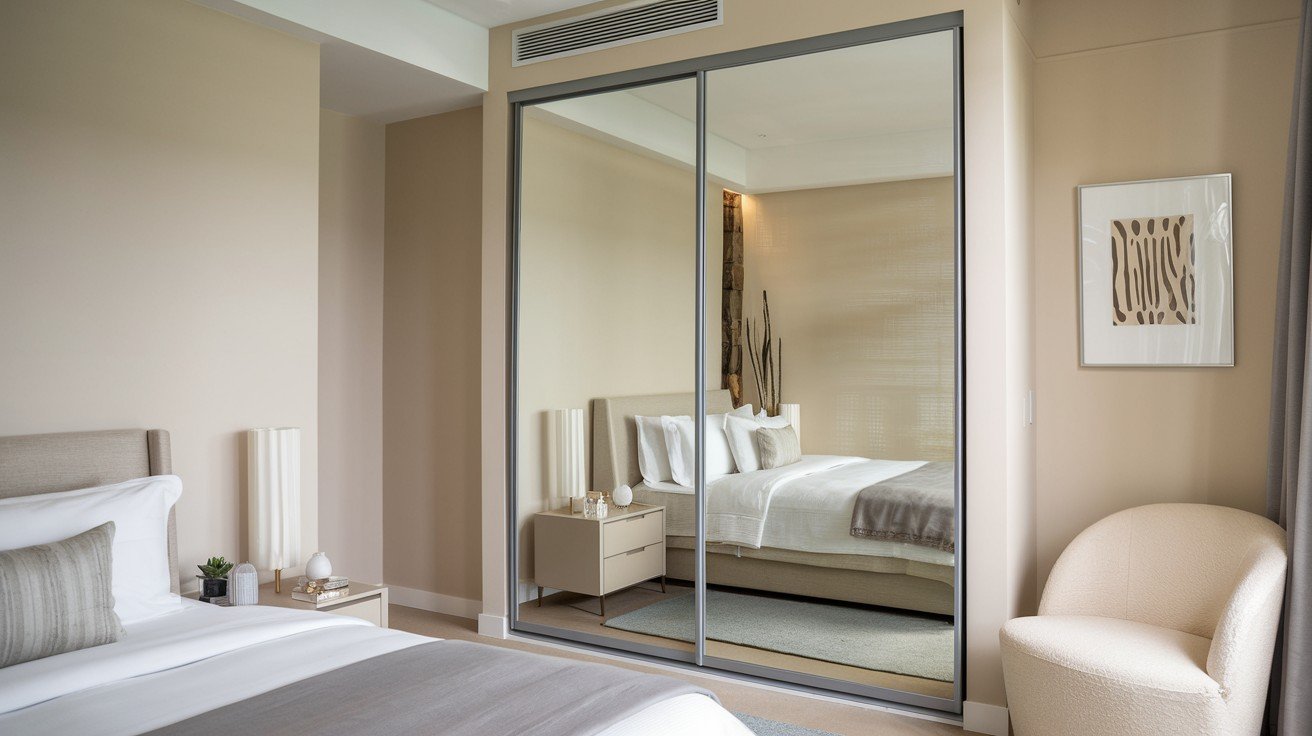
Install a full-length mirror that serves dual purposes as both closet access and room enhancement.
The reflective surface bounces light around small spaces, creating an illusion of doubled square footage. Choose frameless options for seamless integration or decorative frames to match your decor.
This solution works particularly well in bedrooms, dressing areas, or hallways where mirror placement feels natural and purposeful.
3. Wallpaper-Camouflaged Door
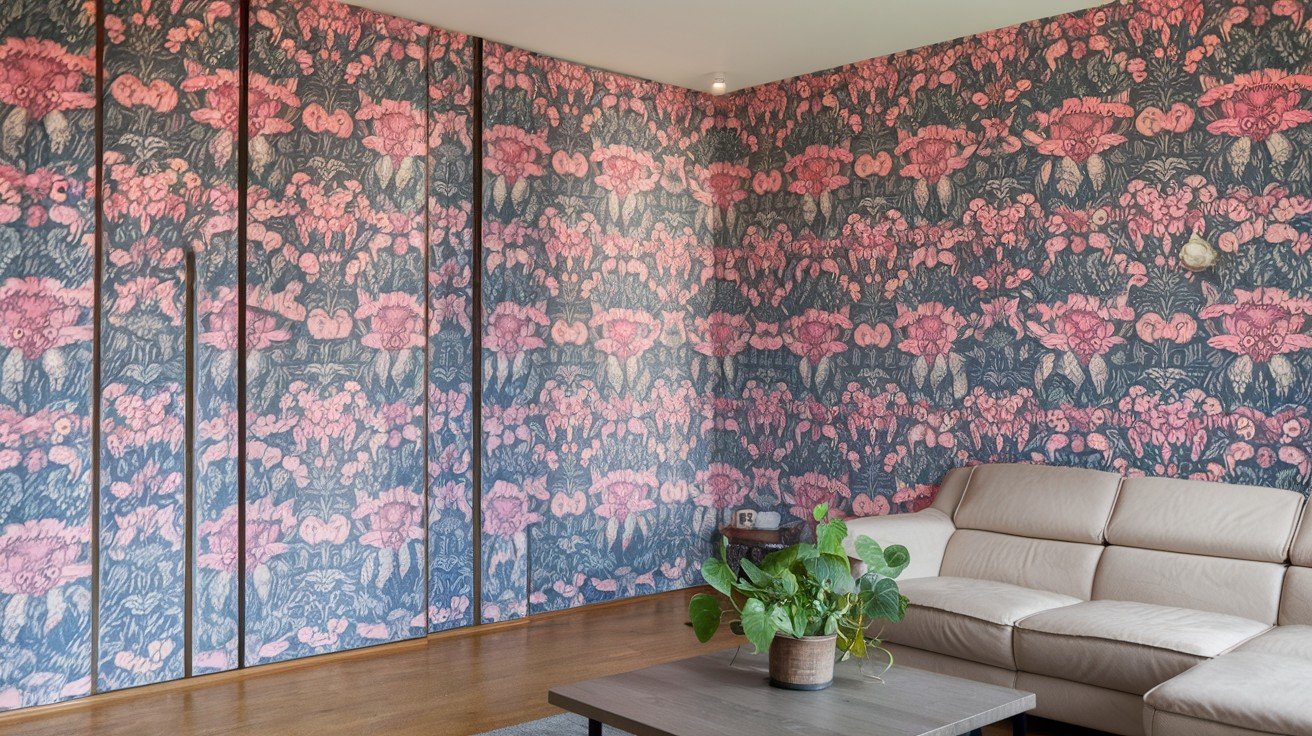
Create complete visual invisibility by matching your closet door perfectly to the surrounding wall surface.
Apply identical wallpaper or paint across both the door and wall, ensuring pattern alignment for seamless integration.
Use push-latch hardware to eliminate visible handles. This technique works with any wall treatment, from bold patterns to subtle textures, making the closet entrance completely disappear into your room’s design scheme.
4. Flush Panel Door
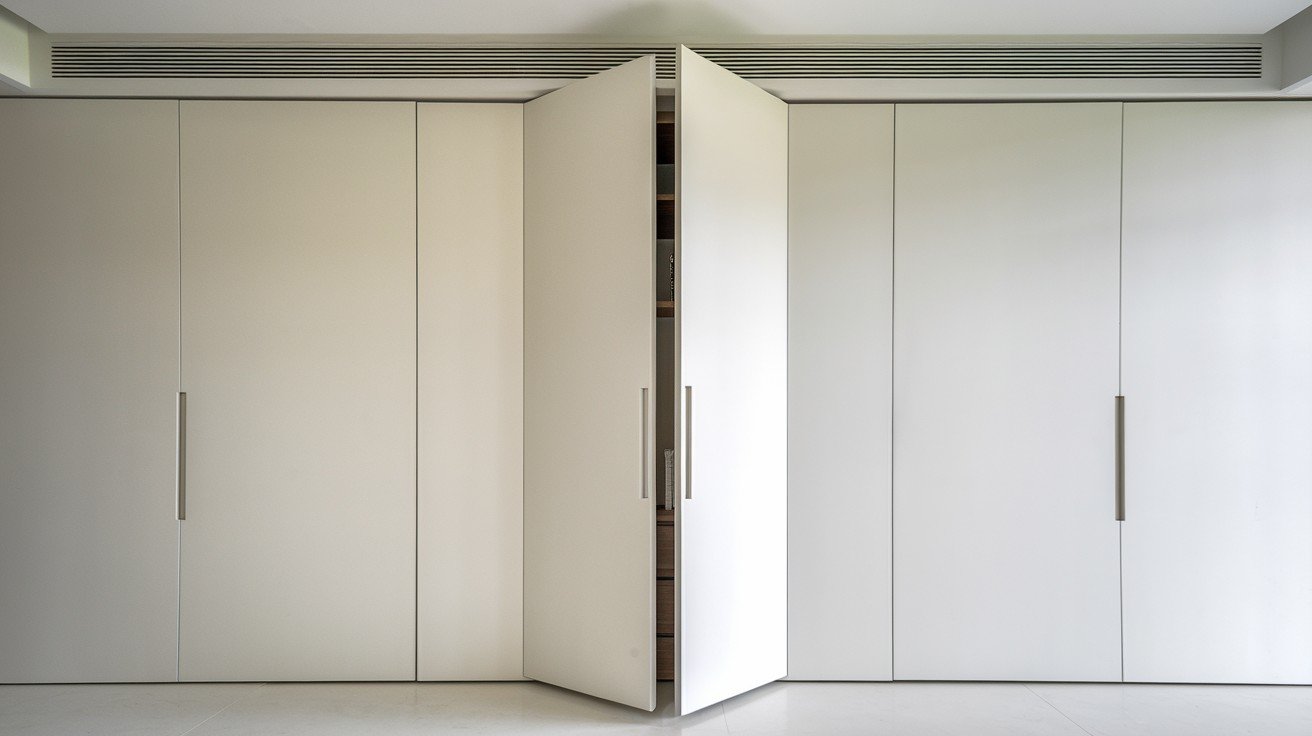
Achieve ultimate minimalism with a completely flat door surface featuring no visible trim, handles, or hardware.
The smooth panel sits flush against the wall frame, opening with a gentle push thanks to concealed latch mechanisms. This ultra-modern approach creates clean architectural lines perfect for contemporary spaces.
The understated design allows wall color or texture to flow uninterrupted, maintaining visual continuity throughout your room.
5. Sliding Barn Door with Hidden Track
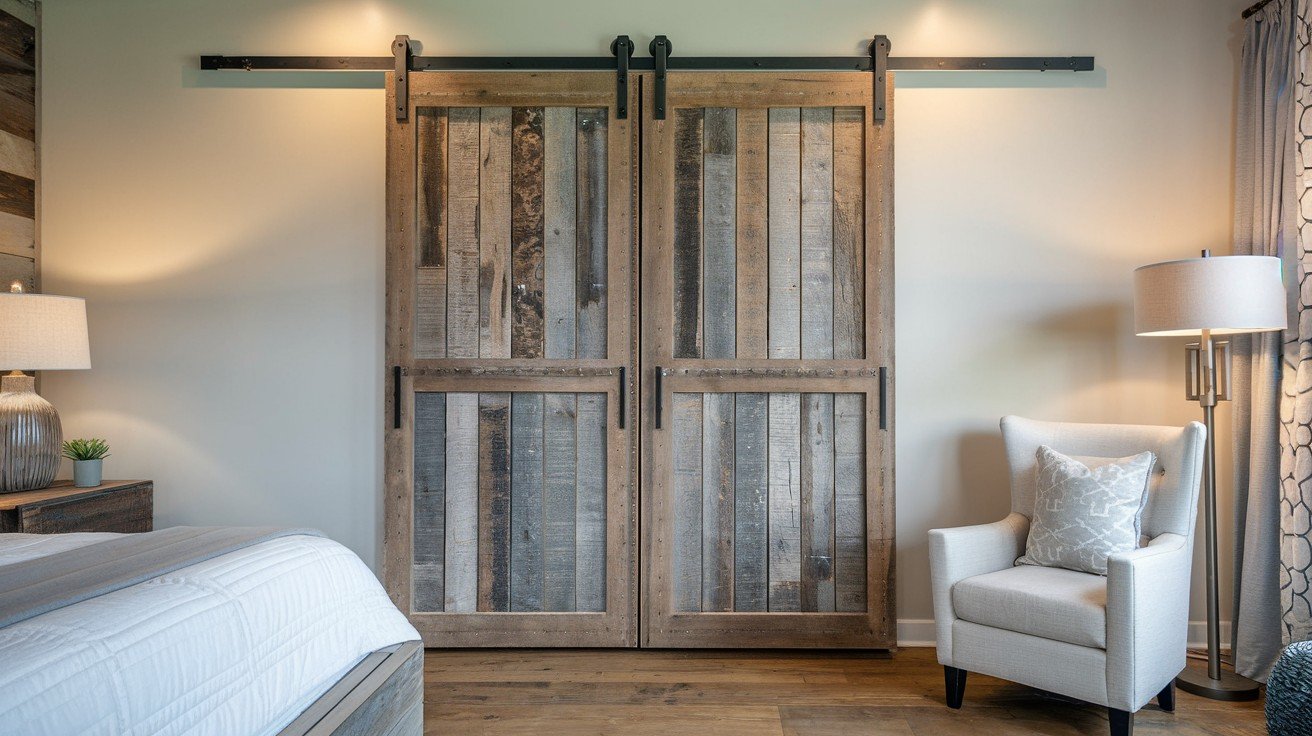
Combine rustic appeal with space-saving functionality using a barn-style door that slides along a concealed track system. The hardware disappears into the ceiling or wall, maintaining clean lines while preserving the door’s charming character.
Choose reclaimed wood, painted finishes, or decorative panels that complement your decor.
When closed, it appears as an attractive wall feature rather than obvious storage access, perfect for farmhouse or industrial-style spaces.
6. Fabric or Curtain Door
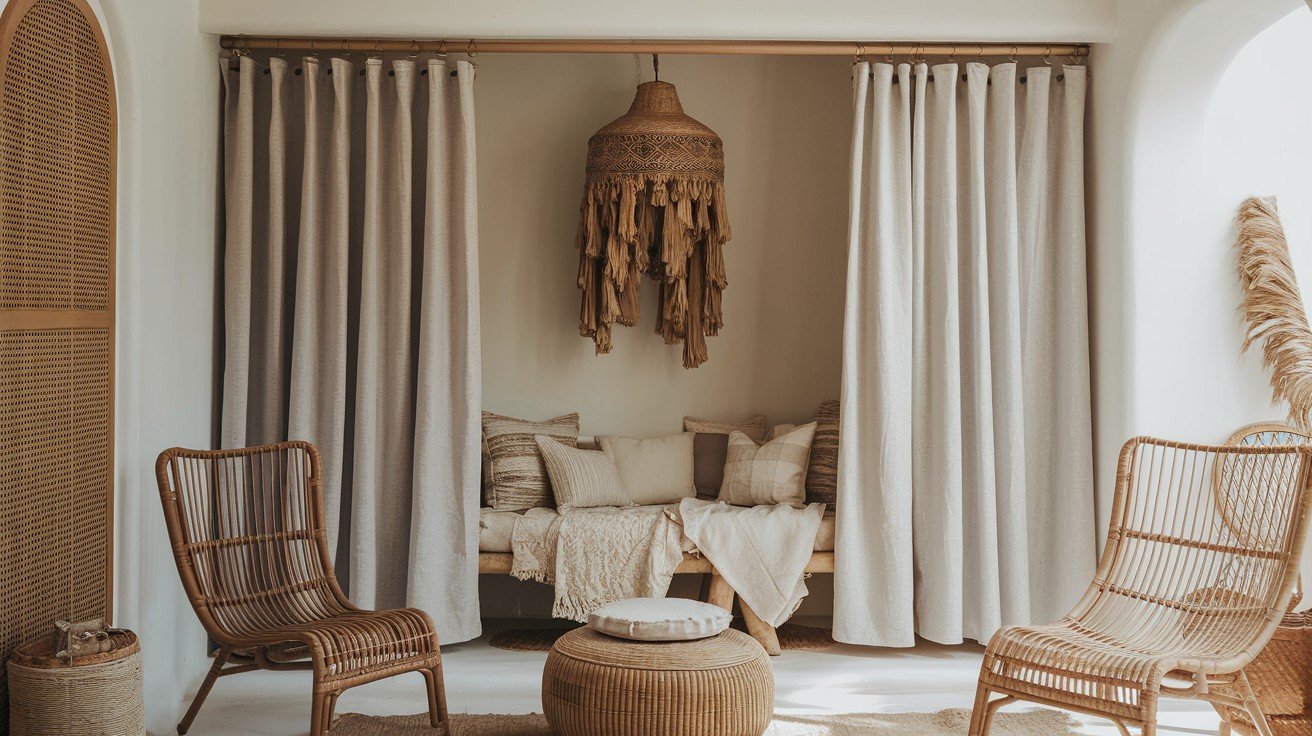
Replace traditional doors with flowing fabric panels hung from ceiling-mounted tracks or tension rods.
This soft alternative adds texture and warmth while providing easy access to your closet contents. Choose fabrics that complement your room’s color scheme; from sheer materials for light filtering to heavy drapes for complete concealment.
Ideal for renters seeking non-permanent modifications or anyone wanting budget-friendly solutions that can change with seasonal decor updates.
7. Paneled Wainscoting Door
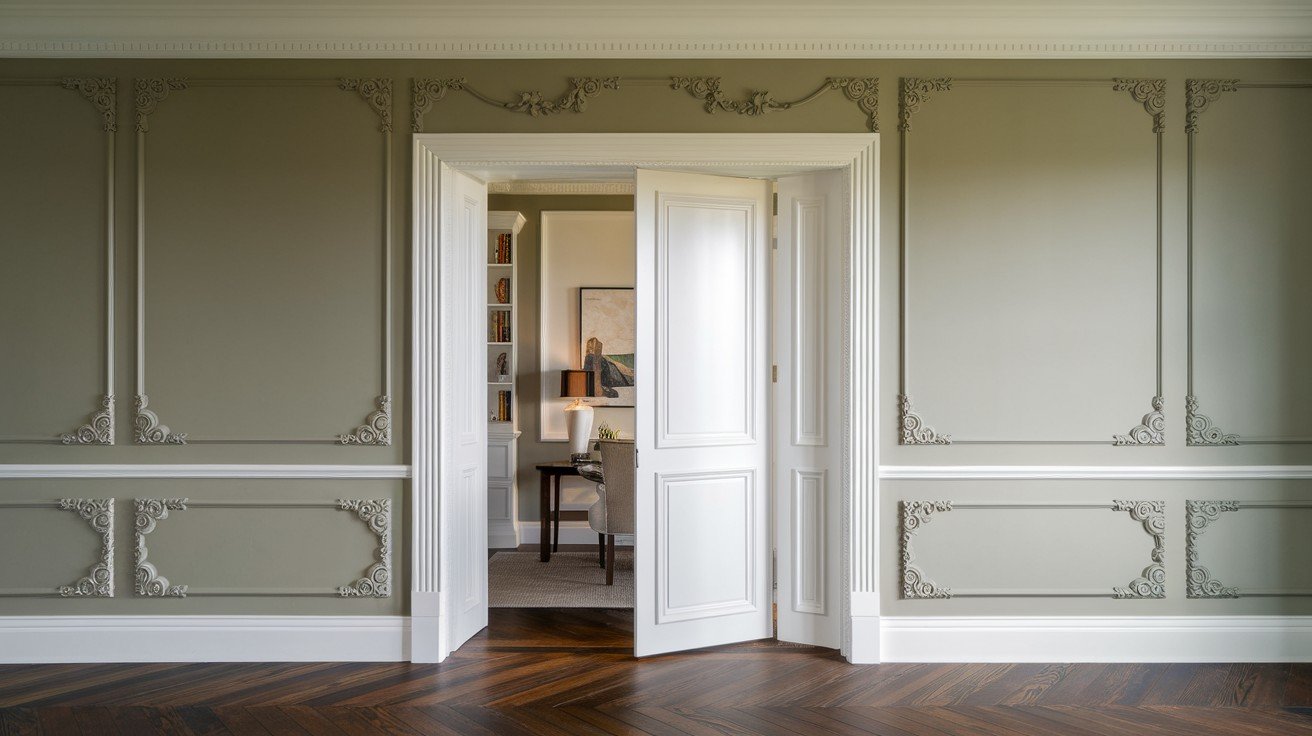
Integrate your closet door seamlessly into existing wall paneling or wainscoting details. The door surface matches the surrounding architectural elements, raised panels, chair rails, or beadboard, creating the illusion of continuous wall treatment.
This approach works beautifully in traditional, colonial, or craftsman-style homes where detailed millwork is expected.
The door becomes invisible within the room’s natural flow, maintaining historical authenticity while providing modern storage solutions.
8. Art Frame Door
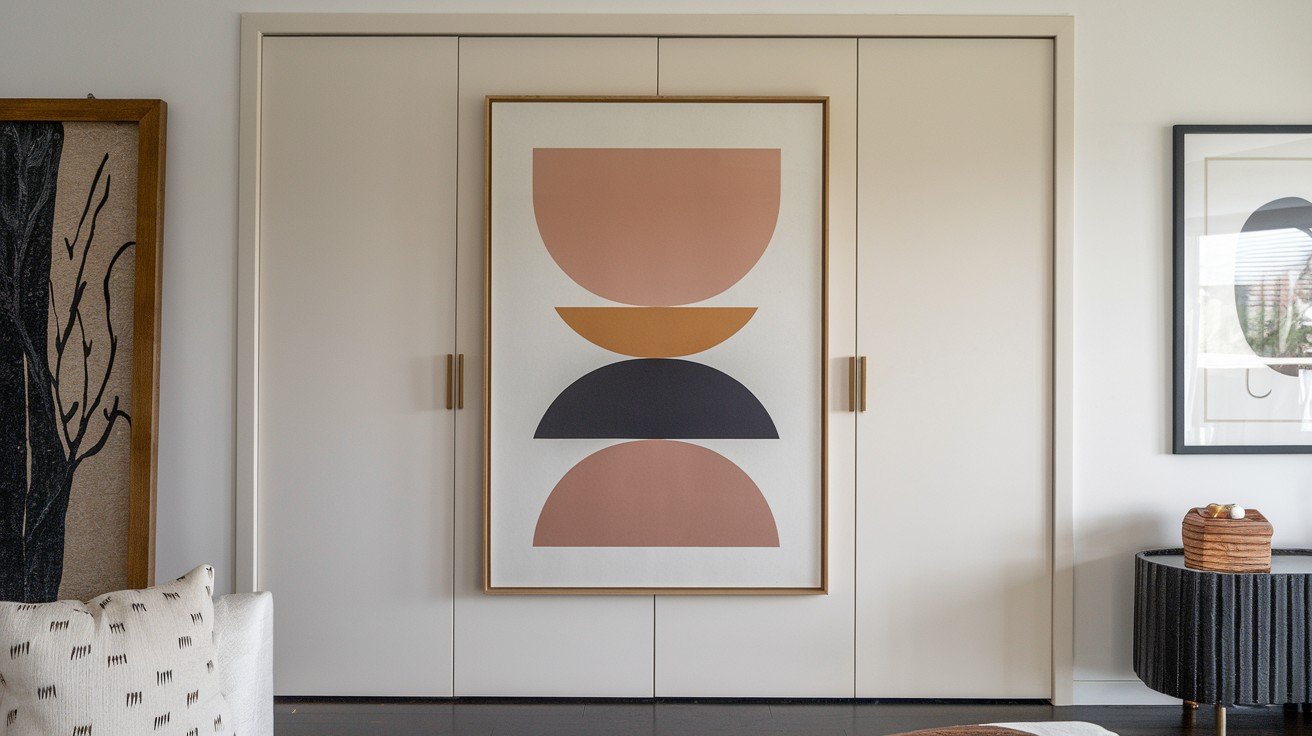
Mount an oversized piece of artwork or a large decorative frame directly onto your closet door surface. Choose pieces that complement your room’s style: abstract paintings, photography, or even fabric art stretched in frames.
The artwork serves as both a focal point and camouflage, drawing attention away from the door’s functional purpose.
This creative solution allows you to display meaningful pieces while maintaining storage access in galleries, bedrooms, or living spaces.
9. Pocket Door
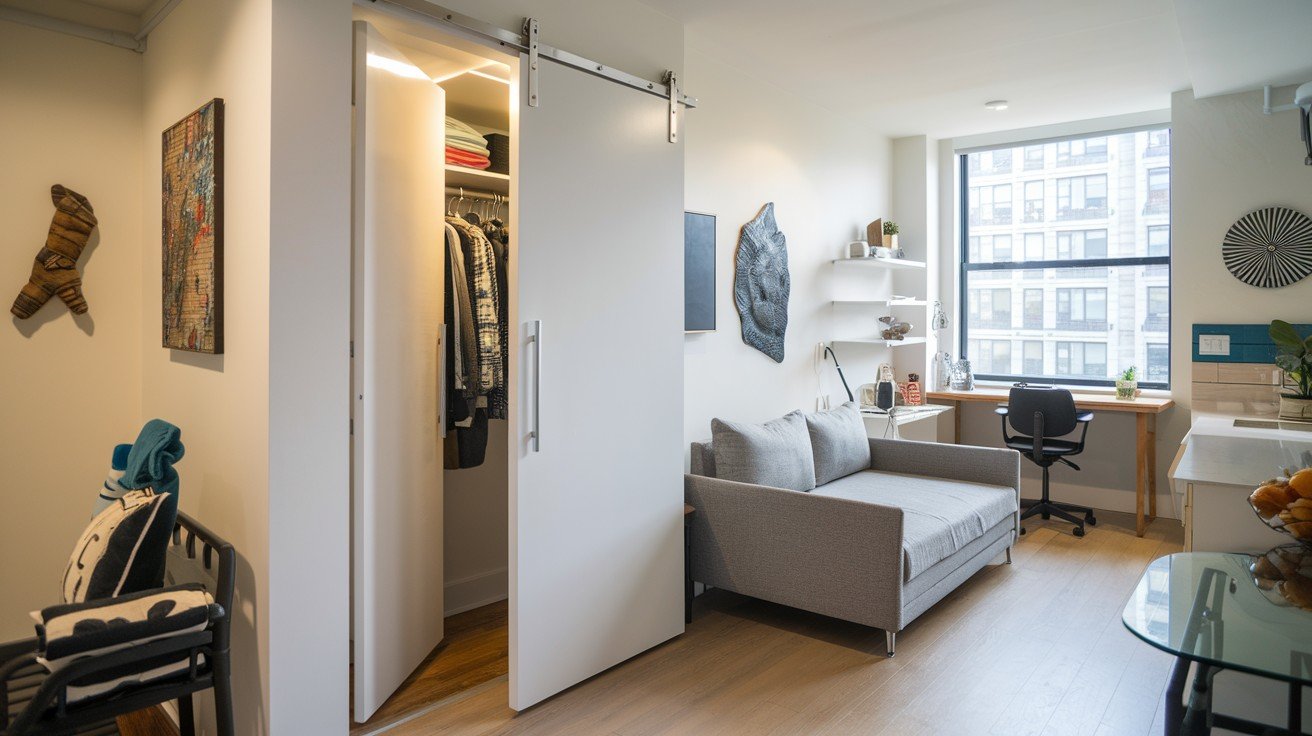
Install a door that completely disappears into a hollow wall cavity when opened, leaving zero footprint in your room.
This ultimate space-saving solution requires wall modification during construction or renovation, but delivers unmatched functionality for cramped quarters.
The door slides on concealed tracks within the wall structure, emerging only when closet access is needed. Perfect for studio apartments, tiny homes, or any situation where every square inch matters.
10. Bi-fold Hidden Door
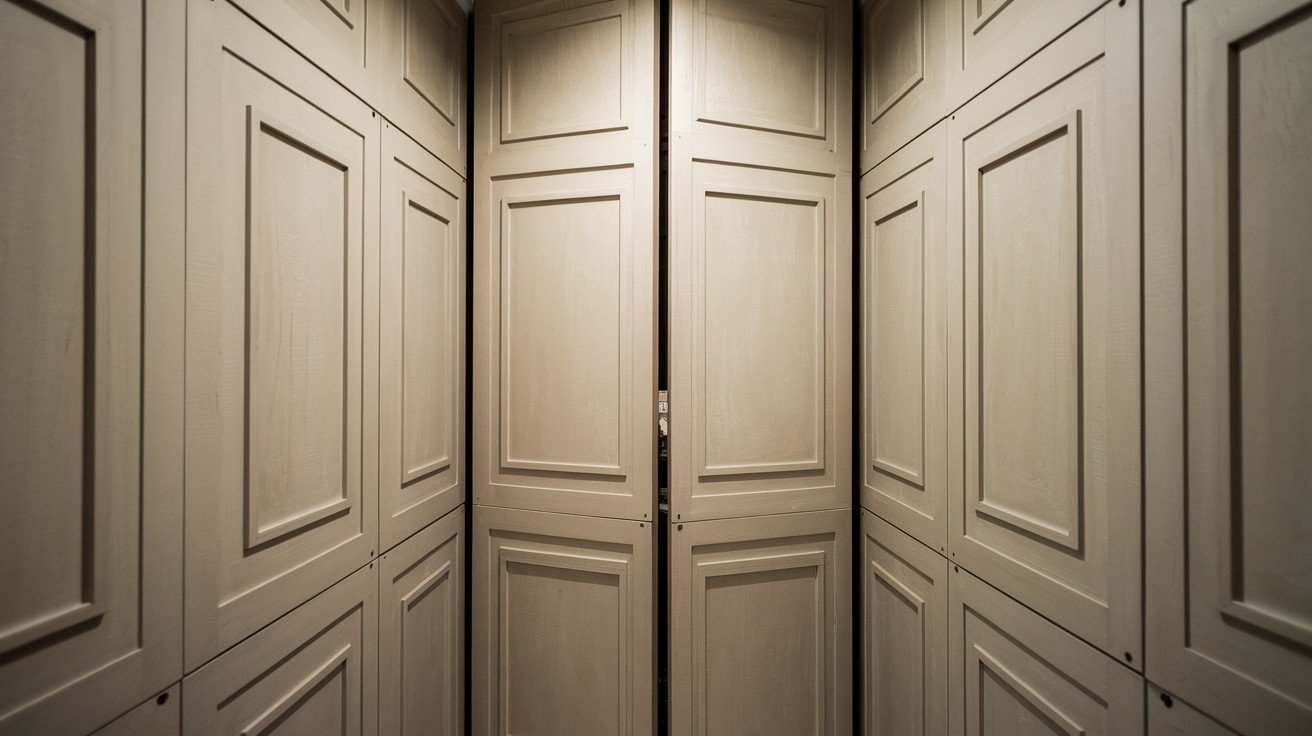
Utilize compact folding mechanisms that allow doors to fold back on themselves, requiring minimal clearance space.
These doors can be designed to mimic surrounding wall treatments, matching paneling, built-in shelving, or decorative elements. The accordion-style opening provides wide access to closet contents while the closed appearance integrates seamlessly with room design.
Ideal for spaces with limited swing room but adequate wall width for folding action.
11. Rotating or Pivot Door
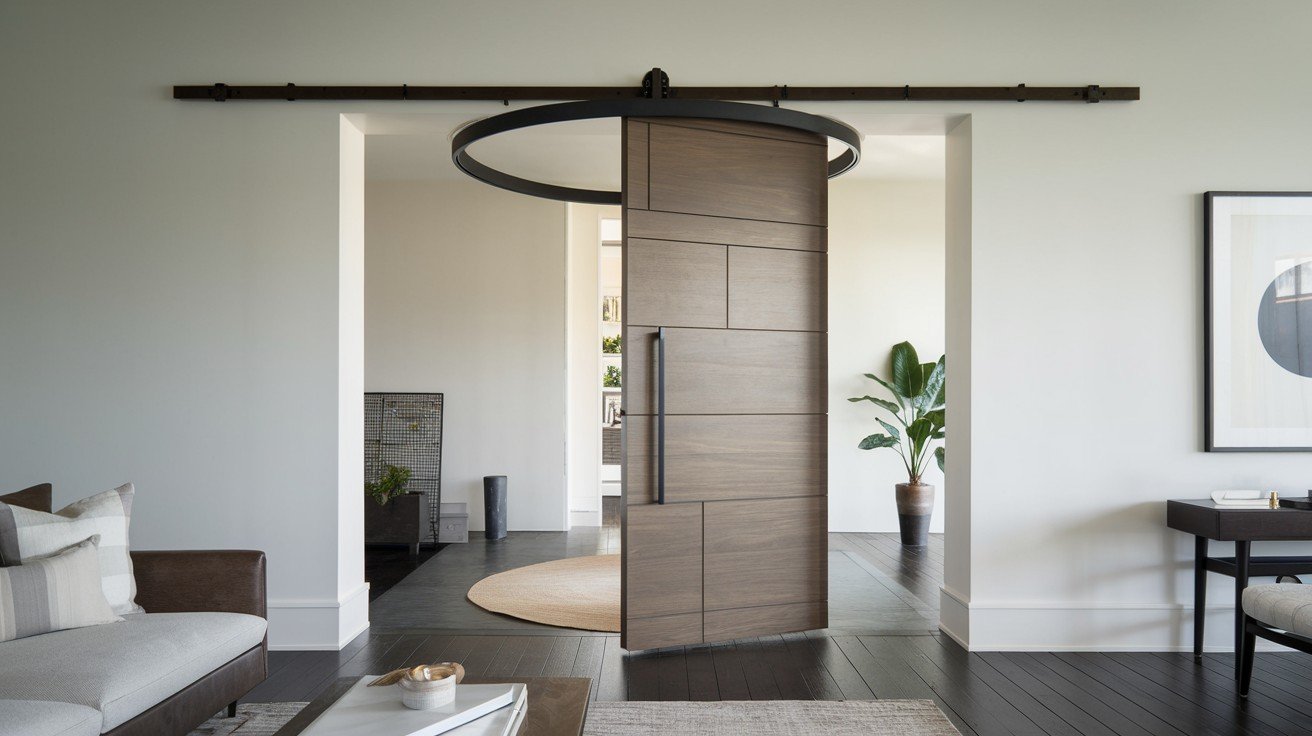
Install a door that rotates around a central axis rather than swinging on traditional side hinges. This innovative mechanism allows the door to spin 180 degrees, requiring minimal clearance while creating dramatic architectural interest.
The pivot hardware can be concealed within the floor and ceiling points, maintaining clean lines. Choose solid panels, glass inserts, or decorative surfaces that complement your space.
This sophisticated solution works particularly well in modern homes where unique design elements are appreciated.
Styling Your Hidden Closet Door
Paint selection determines your door’s visibility; choose matching wall colors for complete camouflage or contrasting shades to create intentional design features.
Textured finishes like faux wood grain, stone patterns, or fabric coverings add visual interest while maintaining concealment.
Handle-free designs using push-latches or magnetic closures maintain clean lines, while discrete pulls can be integrated into decorative elements or recessed into door surfaces.
Consider touch-activated mechanisms for truly modern functionality. Strategic lighting enhances both style and practicality.
Install LED strips along door edges, recessed ceiling lights, or wall sconces to highlight architectural details without revealing the door’s purpose.
Smart technology integration includes motion-activated interior lighting, magnetic locking systems controlled by smartphone apps, and automatic opening mechanisms.
These features add convenience while maintaining the door’s concealed appearance, creating a truly modern storage solution.
Hidden Closet Doors as Design Statements
Sometimes the “hidden” part is more about creativity than invisibility.
Artistic Statement Doors
Upgrade your closet entrance into a gallery-worthy masterpiece with bold abstract paintings or custom murals applied directly to the door surface.
Commission local artists to create original works, or apply large-scale photography and graphic designs.
These doors become conversation pieces while maintaining their functional purpose. The artwork draws attention as intended decor rather than obvious storage, making the door both visible and concealed simultaneously.
Architectural Disguise
Design doors that mimic existing structural elements like decorative columns, pilasters, or elaborate molding systems. These doors appear as intentional architectural features rather than functional openings. Install matching materials and proportions that complement your room’s existing millwork, creating the illusion of permanent wall details while providing full closet access.
Floating Wall Panels
Create contemporary sculptural elements using sleek panels that appear to float slightly away from the wall surface.
These modern installations use hidden mounting systems and dramatic lighting to cast subtle shadows, adding depth and visual interest while concealing storage behind sophisticated geometric forms.
Installation Tips & Tricks
DIY vs. Professional Installation:
- Simple solutions like fabric doors, wallpaper camouflage, and basic mirror installations work well for DIY projects
- Call professionals for pocket doors requiring wall modifications, complex pivot mechanisms, or electrical work
- Bookshelf doors with heavy loads need a structural assessment and proper mounting
- Sliding systems with concealed tracks often require precise measurements and specialized hardware
Hardware Considerations:
- Push-latch systems work best with lightweight doors and smooth wall surfaces
- Heavy-duty hinges support bookshelf doors loaded with books and decorative items
- Soft-close mechanisms prevent slamming and extend hardware lifespan
- Magnetic catches provide silent operation for nighttime access
Daily Functionality:
- Test opening mechanisms regularly to ensure smooth operation
- Choose hardware rated for frequent use in high-traffic closets
- Maintain adequate interior lighting for easy item location
- Consider door weight when selecting clothing storage to prevent sagging
Safety Considerations:
- Install finger guards on bi-fold doors in children’s rooms
- Ensure push-latch mechanisms aren’t too sensitive for accidental opening
- Secure heavy decorative elements to prevent falling hazards
- Use rounded corners and smooth edges on all door surfaces
Conclusion
Hidden closet door ideas offer the perfect solution for maximizing both space and style in compact living areas.
These innovative approaches change necessary storage access into design opportunities, allowing you to maintain a clean look while gaining functional benefits.
From simple fabric panels to sophisticated pivot mechanisms, there’s a concealed door solution for every budget, skill level, and design preference.
The key to success lies in matching your chosen method to your specific needs; consider your daily usage patterns, available space, and existing decor when making selections.
Whether you opt for complete invisibility through camouflaged panels or choose artistic statement pieces that blend function with beauty, these creative solutions prove that small spaces don’t require design compromises.
Start with one closet and experience how hidden doors can turn your home’s flow, functionality, and visual appeal.
Frequently Asked Questions
Do hidden closet doors require special maintenance?
Most need occasional hardware adjustments and cleaning. Push-latch mechanisms may need periodic lubrication for smooth operation.
Can renters install hidden closet doors without damaging walls?
Yes, fabric panels, removable wallpaper, and magnetic attachments work well without permanent modifications or lease violations.
Are hidden doors safe for homes with young children?
With proper installation and child-safe hardware, yes. Avoid heavy decorative elements and ensure latches aren’t overly sensitive.

